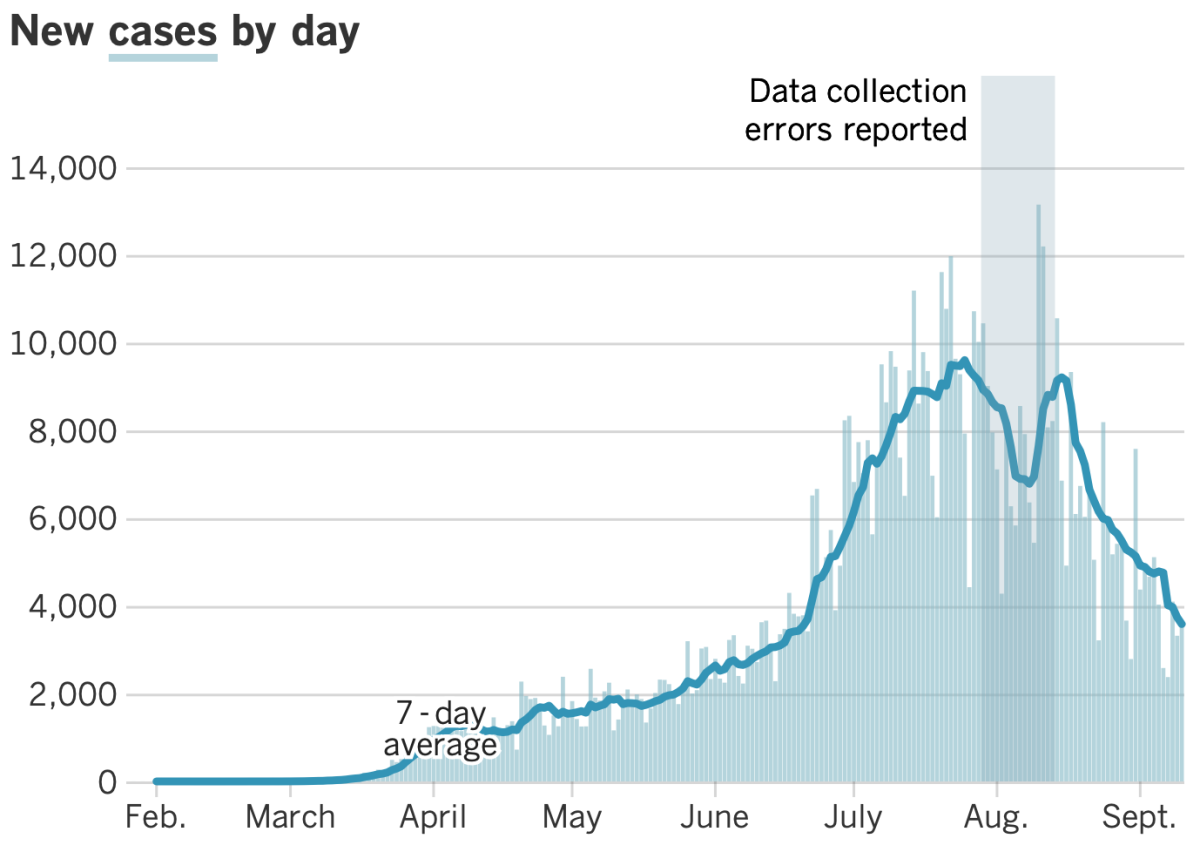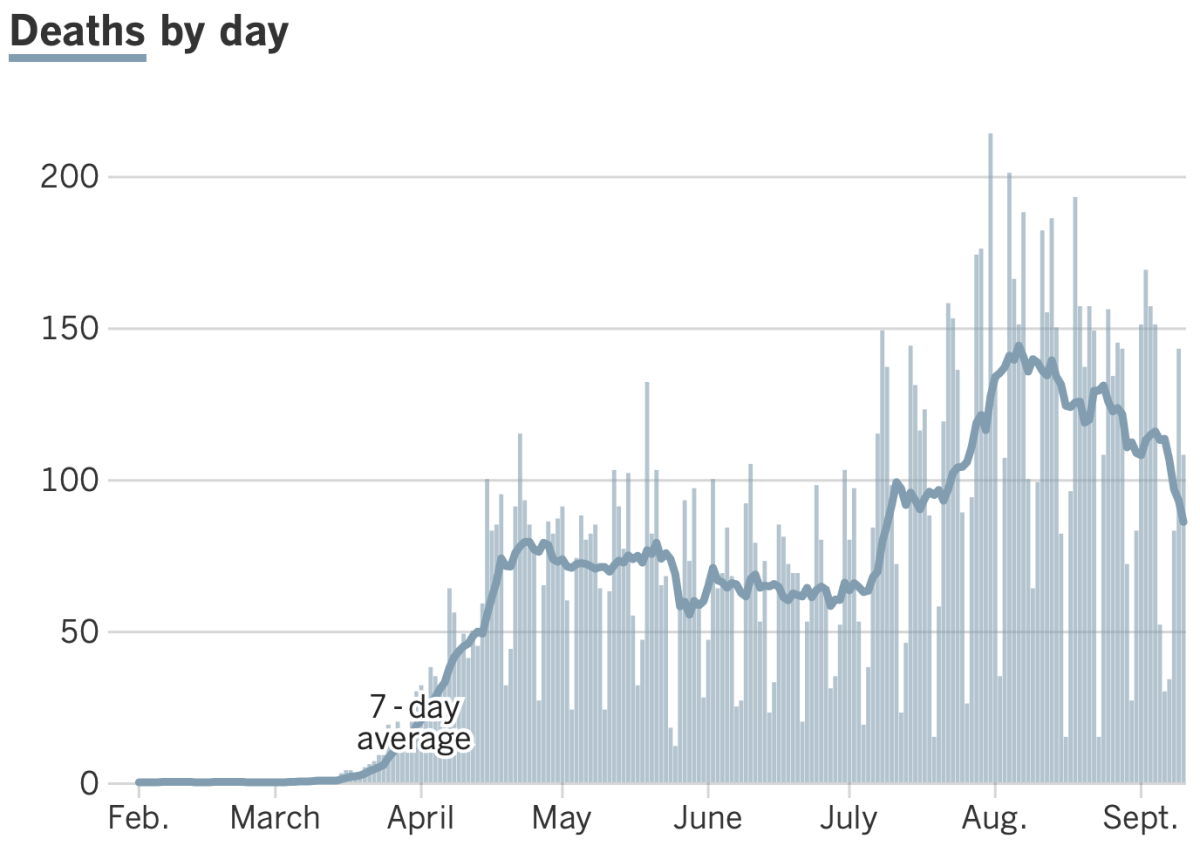Coronavirus Today: Signs of progress
- Share via
Good evening. I’m Soumya Karlamangla, and it’s Friday, Sept. 11. Here’s the latest on what’s happening with the coronavirus, plus ways to spend your weekend and a look back at some of the week’s best stories.
In the seemingly endless flood of news and numbers about COVID-19, it can be difficult to ascertain what we all want to know about the pandemic: Are things improving?
In California at least, the answer appears to be yes. The death toll from the virus crossed 14,000 yesterday, but daily figures for new cases and deaths have been dropping for more than a month. On July 27, the state recorded nearly 11,000 new cases in a single day. Now, that figure is typically around 3,700, according to Times data.


The lines above are seven-day averages. They offer a more stable view of the trend than daily totals. That’s why experts wait for lines like these to flatten before they say conditions are improving. The gray range marks a period when errors in a state computer system delayed the tabulation of new cases.
The percentage of tests coming back positive, an indicator of how widely the virus is spreading in the state, has also fallen. It had crossed 8% in July but now sits just under 4%.
Though encouraged by the progress, officials warn that this is not a moment to let up. Doing so will only allow the numbers to creep back up, which will ultimately lead to more restrictions and deaths, they say.
“We cannot return to normal at this time,” Barbara Ferrer, L.A. County’s public health director, said this week. “We actually need to maintain even more our vigilance so we can continue to suppress the spread of the virus and get to a place where we can safely reopen sectors, especially our schools.”
For now, no campus in L.A. County will be allowed to reopen to all K-12 students until at least November, she advised. However, schools can begin to offer small in-person classes for children with special needs as long as the number of students on campus does not exceed 10% of the overall student body, she said.
By the numbers
California cases and deaths as of 4:36 p.m. PDT Friday:
Track the latest numbers and how they break down in California with our graphics.
See the current status of California’s reopening, county by county, with our tracker.

What to read this weekend
San Diego County is attempting a careful balancing act. For many weeks, the county has had the highest hotel occupancy rates on the West Coast and some of the lowest coronavirus infection and death rates in Southern California. But how long can they keep it up? The worry, of course, is that incautious tourists or complacent locals could imperil everything.
This is what NBA fandom looks like during a pandemic. On a video screen ringing the basketball court, fans’ faces are stitched together to simulate a real audience in the stands. Hundreds of fans do the wave, wiggle their arms to distract opposing free-throw shooters, cheer for baskets and scream after mistakes, just like old times. There is no longer any need to fight traffic or stand in line for pricey concessions. Celebrities such as Lil Wayne, Dwyane Wade and Shaquille O’Neal, who would normally sit courtside, mingle among fans with upper-deck budgets in this strange COVID-19 basketball season.
Can our smartphones save us from COVID-19? Los Angeles County is asking people to download an app that will track their movements so it can notify them if they‘ve been in contact with someone who tested positive for the coronavirus. The new technology is intended to lend a helping hand to the county’s overstretched contact tracers — but the app and its developer are nothing if not controversial.
“It was an adventure for five days, it’s a nightmare for five weeks.” In March, filmmaker Paul Schrader was about three-quarters of the way through the shoot for his film “The Card Counter” when the production was shut down because of the growing pandemic. In July, he was able to resume the shoot for five days and complete the production, but it wasn’t simple. Among the complications: Only one person could be within six feet of an actor at a time.
The pandemic has phones ringing at Trans Lifeline. The only crisis hotline for transgender people operated entirely by transgender people, it has answered more than 65,000 calls over six years. The need to social distance during the COVID-19 pandemic has amplified people’s sense of isolation and loneliness, creating new pressures for the 24/7 hotline. Calls in which people describe suicidal thoughts to operators have increased 89% since March.
Your support helps us deliver the news that matters most.
What to do this weekend
Watch something great. On our weekend culture watch list: A dance memorial for 9/11, plus 17 other picks. There’s just a week until the Emmys, so brush up on the nominees. (We especially recommend catching up on these seven shows.) And in his Indie Focus newsletter, Mark Olsen writes about one film that’s made a new rom-com star and another that maybe didn’t deserve the controversy.
Eat something tasty. This is the kind of weekend we could all probably use a taste of childhood joy — so what better than this dessert that combines kids’ cereal, rainbows and carnival food? Make grilled kalbi, too. Get our Cooking newsletter for more ideas. If you’d rather not cook, consult our ultimate L.A. delivery and take-out guide.
Go online. Here’s The Times’ guide to the internet for when you’re looking for information on self-care, feel like learning something new or interesting, or want to expand your entertainment horizons.
Resources
— For general safety, wash your hands for at least 20 seconds (here’s a super-fun how-to video). Stop touching your face, and keep your phone clean. Practice social distancing, maintaining a six-foot radius of personal space in public. And wear a mask if you leave home. Here’s how to do it right.
— Watch for symptoms including fever, cough, shortness of breath, chills, repeated shaking with chills, muscle pain, headache, sore throat and loss of taste or smell. If you’re worried you might be infected, call your doctor or urgent care clinic before going there.
— Need a COVID-19 test? Here’s how to receive a free test if you’re in L.A. County. And here’s a map of testing sites across California.
— Here’s how to care for someone with COVID-19, from monitoring their symptoms to preventing the virus’ spread.
— If your job has been affected by the pandemic, here’s how to file for unemployment.
— Here are some free resources for restaurant workers and entertainment industry professionals having trouble making ends meet.
— Advice for helping kids navigate pandemic life includes being honest about uncertainties, acknowledging their feelings and sticking to a routine. Here’s guidance from the CDC.
— In need of mental health services? Here are resources for coping during the crisis from the CDC and the L.A. County Department of Mental Health. L.A. County residents can also call (800) 854-7771 or text “LA” to 741741.
— For domestic violence victims, the pandemic can pose a “worst-case scenario,” advocates say. If you or someone you know is experiencing such abuse, call the National Domestic Violence Hotline at 1-800-799-SAFE (7233) or L.A. County’s hotline at 1-800-978-3600. Here are more ways to get help.The pandemic in pictures

As the pandemic swept the country, Richard Kraft, a preeminent agent for film and television composers, felt restless and compelled to do something.
His answer? “Soundtrack of Our Lives,” an earnest ode to all things film and music. More than 150 major actors, singers, songwriters, composers, engineers, musicians and more all volunteered for a show that was created with zero budget and relied on every participant to film his or her own part at home using only a phone. Participants included Catherine O’Hara, Reba McEntire, Sting, Mandy Moore, Hans Zimmer, Darren Criss, Patti LuPone and even Kermit the Frog.
Sometimes from his home in Sherman Oaks, Kraft would direct via FaceTime or Zoom, and he always sent meticulous notes for how to achieve the best technical results. His No. 1 admonition: Please, please film in horizontal, and for goodness’ sake, use your phone’s 4K resolution.
The lo-fi production values now stand as a charming, at times zany testament to the earliest days of COVID-19 and the banding together of the music community to fight it.
Our reporters covering the coronavirus outbreak want to hear from you. Email us your questions, and we’ll do our best to answer them. You can find more answers in our Frequently Asked Questions roundup and in our reopening tracker.
For the most up-to-date coronavirus coverage from The Times over the weekend, visit our homepage and our Health section, sign up for our breaking news alerts, and follow us on Twitter and on Instagram.




